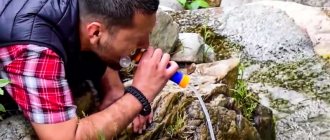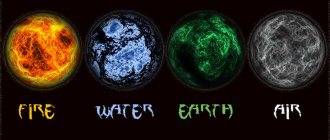Read before going into the desert! Endless sands, lack of moisture, hot air, bright, skin-burning sun - all these are signs of a merciless desert. But even in such an area you can find the most common element on the planet - water. The ability to find water will allow you to survive in the desert for many days and even weeks, while its absence will lead to death from dehydration within three days.
How to find water in the desert
The most realistic places for the accumulation of life-giving moisture are in river beds, on their bends and in lowlands. You should also look for water in the desert in the hollows on the leeward side of the dunes. It’s worth noting right away that success in this matter does not come immediately. In addition, you will need to make an effort to “get to the bottom” of the aquifer.
You can dig in the desert with your hands or any available tool - a spoon, fork, knife, stick, other metal and hard plastic objects. Typically, the aquifer is located in the deepest depression between the highest dunes at a depth of one to two meters. First, the traveler will see a wet horizon, and after some time water will appear in it.
If you are in a desert among the mountains, then the aquifer may come to the surface on steep slopes. Water can also be located in deep depressions. The presence of vegetation in such places directly indicates the presence of life-giving moisture. In addition, in the mountains, water sometimes accumulates under a thin layer of topsoil. The presence of moisture is also indicated by drops on the rocks, which are a sign of evaporation.
Other factors that can help in finding water include:
• The presence of midges that swarm over one place after sunset. • Presence of vegetation – grass, tree bushes. • Presence of a single date palm (true in Africa) or poplar (Populus diversifolia).
In many places in the deserts there are artificial wells designed to support the strength of travelers. They are needed by caravans, shepherds, and lost wanderers. It is worth carefully examining the surrounding area in search of such a place, since wells are usually carefully hidden from the sun and are invisible over long distances.
If you come across a caravan trail, such a well can be found by:
• The presence of side paths. • The presence of animal trails – trampled paths with droppings. • By the presence of a pile of stones and branches with a sign in the form of matter or bone. This is "Obo" (in Central Asia) - a sacred sign, often indicating the presence of a source of water.
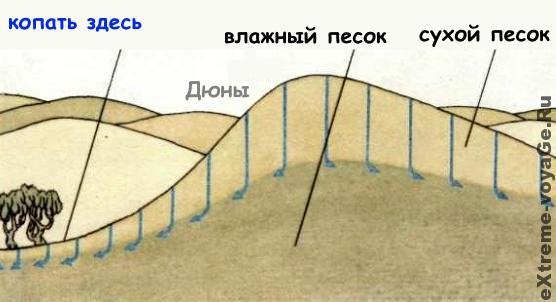
How to find water in the desert
You need to look for fresh water in the desert and at the bottom of the sea
One of the most dramatic problems that humanity will have to face in the near future is the lack of fresh water. According to the UN, due to population growth, the development of industry and irrigated agriculture, its consumption has doubled compared to the last century. Today, more than 40% of the world's inhabitants are forced to survive in conditions of water scarcity, and by 2030 this figure will increase to 47%. Analysts do not exclude that in the future real wars for access to water may break out, and trade in life-giving moisture will become no less profitable than the oil business today. Is there a chance to replay the catastrophic scenario? The answer may lie... under the ocean floor.
Australian scientists from Flinders University have proven the presence of huge reserves of fresh water below the ocean floor (research results published in the journal Nature). As often happens, the discovery was made by accident: they were looking for oil and gas, but found water. According to hydrologists, on the continental shelf off the coast of Australia, China, North and South America, about 500 thousand cubic kilometers of fresh or slightly saline water lie in “suboceanic” reservoirs. This is 100 times more than the entire volume of water extracted from the depths of the earth during the entire twentieth century!
You need to look for fresh water at the bottom of the sea
Having analyzed both new data and those obtained earlier, scientists came to the understanding that huge “bottomed” reserves of fresh water are a fairly common phenomenon, and not at all exceptional, as was believed until recently. For example, in 2007, in China, during the implementation of a state geological exploration program, the task of which was to search for new fresh water reserves, geologists discovered a lake with clean drinking water under the ocean floor in Zhejiang province off the eastern coast of the country.
The reservoir is located near the Zhusan Islands at a depth of 300 meters. It is divided into layers, and each of them contains more fresh water reserves than the previous one. If the first layer can produce up to 10 thousand cubic meters of water per day, then the third – already 80 thousand cubic meters. The presence of subbottom water lenses is explained by the fact that the Zhusan Islands, in fact, represent a shelf extension of the mainland, where underground rivers discovered a little earlier flow. Freshwater reservoirs are much older than the oceans that hide them: they were formed over hundreds of thousands of years at a time when sea levels were much lower.
The current seafloor was once dry land, watered by ancient rains that fed the water table. Then, as a result of the melting of polar ice, the level of the World Ocean rose, many coastal land areas disappeared under salty waves, but aquifers (aquifers) remained fresh under a layer of clay and sedimentary rocks. The water in them is slightly saltier than fresh water, but the salt content in it is no more than 10 grams per liter (for sea water on average 35 grams per liter), so it is quite suitable for use. Extracting fresh water from such aquifers can be cheaper than desalinating seawater, but drilling must be done very carefully so as not to damage the source.
A whole sea splashes under the Sahara Desert
It is curious that powerful reserves of fresh water lie not only under the salty waters of the oceans, but also under oceans of sand in the driest regions of the Earth. So, under the Sahara Desert splashes the so-called Savornina Sea. Despite the almost Russian sound of the surname, Justin Savornin is French. Geologist and hydrologist, African explorer and traveler, back in the 30s of the last century he discovered huge accumulations of fresh water under the Sahara, which were named in his honor. Here, on an area of 800 thousand square kilometers, a fresh water reserve of about 50–70 billion cubic meters is stored. These are relict waters, the accumulation of which occurred during the humid epochs of the Pleistocene. But the Savornina Sea continues to replenish to this day: on the slopes of the mountains lying south of the Sahara, rain falls regularly, and their streams, seeping through the ground, feed underground water storage facilities.
On this topic
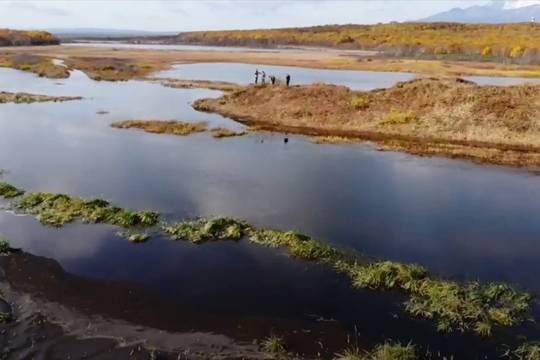
1699
Scientists have discovered unusual sediments at the bottom of a river in Kamchatka and noticed changes in the color of the water
Amid investigations into the situation in Kamchatka, where thousands of dead marine animals were washed up on beaches, scientists noted that unusual color changes and dense sediments on the bottom appeared in a tributary of the Nalycheva River, which flows into Avachinsky Bay.
The use of underground Saharan waters would make it possible to obtain 1 thousand cubic meters of water every minute for 500 years - quite enough to literally and figuratively water the desert. Libya and Egypt already take this water for irrigation, but only a tiny fraction of the capacity of the underground basins is used. Employees of the British Geological Council and University College London have compiled the most detailed map of Africa's water resources to date, which also takes into account the hidden potential of underground horizons.
The most significant reserves are hidden in sedimentary rocks under Libya, Algeria and Chad. The total volume of water in the depths of the Black Continent is 100 times greater than the contents of its surface reservoirs. To illustrate: they could flood these territories with 75 meters of water. Water reserves have also been discovered in Kenya. Last year, at the initiative of the government of this country and the UN, Radar Technologies International (RTI) used space technology to survey Turkana County, one of the poorest and driest regions in northern Kenya. As a result, it turned out that a total of 250 trillion liters of groundwater lurks in the depths of these inhospitable lands! It's enough to keep you alive
40 million people.
Most of the water reserves are concentrated in five deep underground reservoirs. In addition, significant volumes of water (about 2 billion cubic meters) are located in the aquifer, which runs literally a few meters underground. This water is easily accessible, which opens up great prospects for local agriculture. Several years ago, Russian scientists also had a hand in the search for unknown desert waters. At the request of the government of Mauritania, a group of geologists from the Research Center for Geoinformation Analysis of the Earth, led by Doctor of Geological and Mineralogical Sciences Vladimir Polevanov, conducted remote sensing of the earth's surface from space in order to search for underground fresh water. In the Varan desert, not far from the city of Atar, an underground river was discovered that could water a city with a population of 50 thousand for several decades.
Water almost flooded the city
However, this begs the question: what will happen when this source dries up? After all, several decades are negligible even from the point of view of one generation...
As Polevanov explains, the groundwater of the Sahara belongs to the artesian basin. However, the lion's share of the world's water reserves is concentrated in such reservoirs, and their area can be super-giant! The largest artesian basin in the world is the West Siberian basin - its area is almost 3.5 million square kilometers, and the drainage area covers the space from the Urals to the Yenisei. The second largest Great Artesian Basin in Australia occupies about a quarter of the entire continent. Hidden under the Sahara Desert are two large artesian basins: the Algerian-Libyan and the Libyan-Nile, whose aquifer thickness reaches 500 meters.
The history of the discovery of artesian waters is as follows. In 1126, a serious water supply problem arose in the French province of Artois. A certain local resident undertook to find water for his fellow citizens and began digging a well. He dug and dug, stubbornly making his way through layers of waterless clay, and when even his selfless perseverance was about to crack, the bottom of the well suddenly moved and swelled. The man barely had time to jump out of the hole when the well shaft began to rapidly fill with rising water. It reached the surface and began to flow like a fountain, so much so that it almost flooded the city - it was necessary to dig diversion ditches. However, since then there have been no problems with water in the city. This is how “deposits” of groundwater were discovered that were capable of self-flowing to the surface. In honor of the province of Artois, they began to be called artesian...
How to make life easier when there is no water
In addition to aquifers and springs in the desert, ordinary dew can help survive. To do this, before dawn, you need to collect and place smooth stones together. As a result, moisture condenses on them and after dawn it will help at least slightly support the life support of the body.
If you come across salt lakes or a small body of water, you should not drink the water from it. A large amount of minerals will cause stomach upset, which will lead to even greater moisture loss. But you can moisten your clothes and bandana with this water, which will reduce moisture loss.
If you find yourself in a desert in winter, frost will help you get fresh water from a salt lake. To do this, pour water into any container, wait until it freezes more than half, and pour out the rest. If the water is still too salty, the procedure should be repeated.
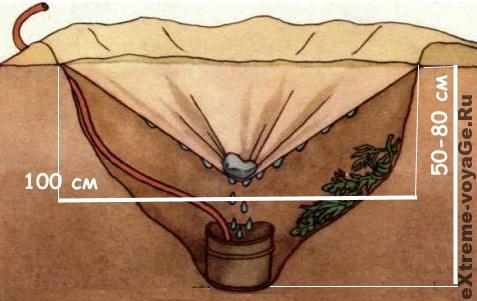
Water from thin air
The main sources of fresh water suitable for drinking are lakes, rivers and rain, melting ice. Due to pollution and drying up of sources, water shortages begin to be felt in places where there used to be enough water.
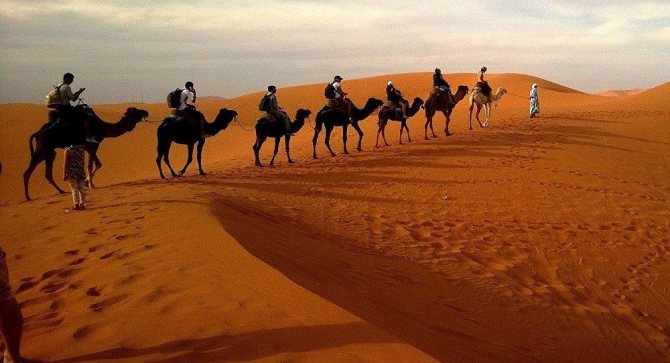
In many countries, water is already obtained through seawater desalination. But another 13 trillion tons are out in the open air all around us.
But until now it was unknown how to extract water from the air on an industrial scale. Researchers from Saudi Arabia have announced that they have a solution to this problem. They invented a simple device that can collect and store water.
The invention uses the properties of cheap, environmentally friendly and non-toxic calcium chloride. The salt sorbent absorbs water so quickly that it literally dissolves before our eyes in minutes if left in the fresh air. It can absorb 6 times its own weight in water.
A little warmth: baby photos of animals from a Finnish photographer
Lady Gaga is actually brown-haired: the stars have natural hair colors
Wardrobe in the attic: husband created a wardrobe for his wife from unnecessary space (photo)
The difficulty was in the subsequent separation of water from salt, which would require expensive installations.

